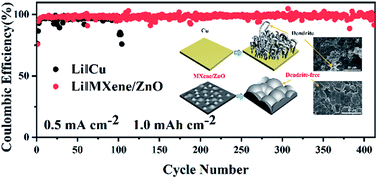MXene/ZnO flexible freestanding film as a dendrite-free support in lithium metal batteries†
Abstract
The growth of lithium dendrites during the charge/discharge process is one major obstacle for the development of lithium metal batteries. In this work, an MXene/ZnO flexible freestanding film was obtained to suppress lithium dendrite growth by combining ZnO nanoparticles with two-dimensional MXene (Ti3C2Tx) through simple vacuum filtration. In the freestanding film, ZnO nanoparticles are uniformly distributed between the layers of MXene nanosheets. The introduction of ZnO nanoparticles not only reduces the nucleation barrier of lithium metal deposition, but also alleviates damage to the MXene substrate by lithium. As a support of lithium, the assembled half-cell can be cycled stably at 0.5 to 3 mA cm−2 current density and show a coulombic efficiency of 98.3% at 0.5 mA cm−2. Scanning electron microscopy measurements disclose the lithium dendrite-less nature during the charge/discharge process. Furthermore, the full cell using Li4Ti5O12 (cathode) and deposited lithium metal on the MXene/ZnO substrate surface (anode) can be cycled stably 1200 times at a current density of 0.875 mA g−1, and the capacity attenuation per cycle is only 0.0113%. These results display the great potential of the fabricated film in lithium metal batteries.



 Please wait while we load your content...
Please wait while we load your content...